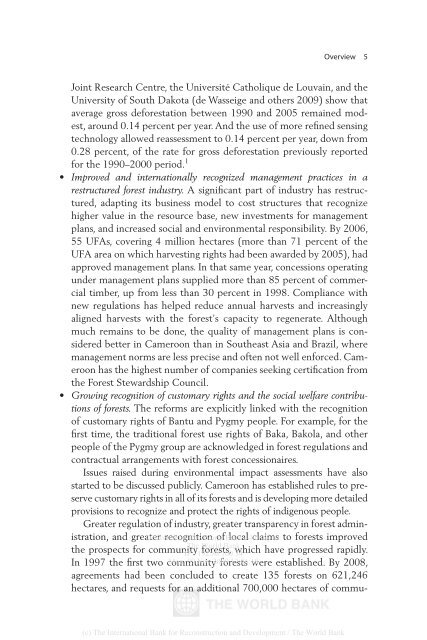The Rainforests of Cameroon - PROFOR
The Rainforests of Cameroon - PROFOR
The Rainforests of Cameroon - PROFOR
- No tags were found...
You also want an ePaper? Increase the reach of your titles
YUMPU automatically turns print PDFs into web optimized ePapers that Google loves.
Overview 5Joint Research Centre, the Université Catholique de Louvain, and theUniversity <strong>of</strong> South Dakota (de Wasseige and others 2009) show thataverage gross deforestation between 1990 and 2005 remained modest,around 0.14 percent per year. And the use <strong>of</strong> more refined sensingtechnology allowed reassessment to 0.14 percent per year, down from0.28 percent, <strong>of</strong> the rate for gross deforestation previously reportedfor the 1990–2000 period. 1• Improved and internationally recognized management practices in arestructured forest industry. A significant part <strong>of</strong> industry has restructured,adapting its business model to cost structures that recognizehigher value in the resource base, new investments for managementplans, and increased social and environmental responsibility. By 2006,55 UFAs, covering 4 million hectares (more than 71 percent <strong>of</strong> theUFA area on which harvesting rights had been awarded by 2005), hadapproved management plans. In that same year, concessions operatingunder management plans supplied more than 85 percent <strong>of</strong> commercialtimber, up from less than 30 percent in 1998. Compliance withnew regulations has helped reduce annual harvests and increasinglyaligned harvests with the forest’s capacity to regenerate. Althoughmuch remains to be done, the quality <strong>of</strong> management plans is consideredbetter in <strong>Cameroon</strong> than in Southeast Asia and Brazil, wheremanagement norms are less precise and <strong>of</strong>ten not well enforced. <strong>Cameroon</strong>has the highest number <strong>of</strong> companies seeking certification fromthe Forest Stewardship Council.• Growing recognition <strong>of</strong> customary rights and the social welfare contributions<strong>of</strong> forests. <strong>The</strong> reforms are explicitly linked with the recognition<strong>of</strong> customary rights <strong>of</strong> Bantu and Pygmy people. For example, for thefirst time, the traditional forest use rights <strong>of</strong> Baka, Bakola, and otherpeople <strong>of</strong> the Pygmy group are acknowledged in forest regulations andcontractual arrangements with forest concessionaires.Issues raised during environmental impact assessments have alsostarted to be discussed publicly. <strong>Cameroon</strong> has established rules to preservecustomary rights in all <strong>of</strong> its forests and is developing more detailedprovisions to recognize and protect the rights <strong>of</strong> indigenous people.Greater regulation <strong>of</strong> industry, greater transparency in forest administration,and greater Delivered recognition by <strong>The</strong> World <strong>of</strong> Bank local e-library claims to: to forests improved<strong>The</strong> World Bankthe prospects for community IP : 192.86.100.34 forests, which have progressed rapidly.In 1997 the first two community Mon, 09 Nov 2009 forests 17:06:18 were established. By 2008,agreements had been concluded to create 135 forests on 621,246hectares, and requests for an additional 700,000 hectares <strong>of</strong> commu-(c) <strong>The</strong> International Bank for Reconstruction and Development / <strong>The</strong> World Bank
















